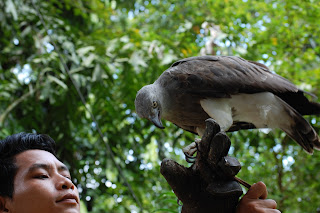Koala Lumpur, yes, filled with
animals; especially tourists, which are honestly nothing more than (party) animals, not to
mention the fact that the city is one of the major hubs in Asia altogether. It
was supposed to be just a stop-over for me but, as I missed my flight to Laos,
it turned into almost a week of pure terror of shopping malls and designer
stores, offering mostly drunk and/or overdressed tourists out on a shopping
spree.
Still, it’s not all that bad,
considering the fact that, for the first time in three months, I’ve stopped
having to scoop the dirt from under my fingernails with toothpicks. If I didn’t
have virtually any type of cultural shock when arriving in India, I had a big
one now, as the city – and, probably, most of the country – is clean,
civilized, honk-free and with traffic rules that are mostly being followed!
Also, it’s hot and not the Indian type of hot, but the moist, humid one, that is
as irritating as ever even in the early hours of the morning. The rain doesn’t
change things to the better, because, by the time the water reaches the ground,
it’s as hot as the atmosphere around. All this mostly translates into me being
continuously hot and sweaty and, thus, making a fool of myself in the eyes of
better acclimatized people.
There are things to see in Kuala
Lumpur (KL, as everybody cockers it) besides the shopping malls. One of them is
the Batu Caves, my first tourist attraction in Malaysia, somewhat close to
India, because these are Hindu caves with Hindu temples and Hindu gods
everywhere inside, the least I could do about not missing India so much. The
shrines inside the caves are your usual guano-smelling Indian temples, not
exactly something unique but there is a cave that’s worth visiting, namely ‘The Dark Cave’,
a really cool 2 km long (for visitors, at least) conservation area with several
types of spiders and other crawling creatures, as well as different species of
bats. As the basic description already states, the cave has a ‘unique guano-driven
ecosystem’, which basically means it stinks but, with enough light (that you’re
obviously not supposed to shine at the bats), you can see lots of impressive
cave formations (stalactites and stalagmites) and, sometimes – when enough
visitors shine their torches in the same direction – you can take pictures of
the caves.
The other KL landmarks that are a
must-see for any tourist passing through are the National Mosque, a modern type
of structure, designed to house, at its maximum capacity, 15000 people, where
tourists can enter only bearing very stylish purple druid-like cloaks, or, in
my case, as I was almost properly dressed, only a headscarf that was lovingly
fitted on my head by the attendants at the entrance.
There’s the Islamic Museum, which was
kindly recommended by the Syrian receptionist at the hostel, exhibiting miniature
mosques from all around the world, Islamic religious items, ceramics and some
collections from neighboring India, Thailand and other countries. It was an
accumulating experience but mostly, it helped me stay out of the daily rain,
from which everybody tried to find shelter although the rain still gives the
tiniest feeling of refreshment (by the way: why would you cover your head only and leave the rest of your body to be soaked to the bone?).
And then there’s the Bird Park. Supposedly
the biggest free bird park in the world (and by ‘free’ I do not, under any
circumstances, mean that it’s free of charge – Allah forbid! – but that the
birds are, indeed, free to fly or just bob around the compound, under the
hungry eyes of visitors). And there’s a pretty large variety of birds that are
flying around, most of them totally unknown to me (but possibly identifying them from the
boards set up all over the place), yet not less beautiful or impressive. The park
is divided into different areas and has various activities throughout the day for
the delight and pleasure of kids and adults alike: different feeding times for
different species of birds, photo booths with all types of feathered friends
and a ‘talent show’ with some of the stars of the park; a little corny perhaps
but nonetheless impressive, especially the eagles flying over the auditorium to
their trainer.
And now the rest of them but do not ask me for any names because I mostly
forgot them. What I didn’t forget are the myriad of colors and the immensity of
sounds – from catlike meowing to desperate childlike shrieks to melodious
birdsong.
One last thing you need to see in KL
and that is exactly what the city is known for: the Petronas Towers; not the
tallest in the city (hell, you get a downwards view toward the towers from the
much taller Menara Tower)
but with a definite charm, mostly by night (I ended up getting there on the
public free bus that drives through downtown KL but which stops its rounds at
11 PM and does not drive back and so it left me stranded in front of the
towers, from where I had to take a taxi back to the guesthouse and, insisting
on the meter, only paid an feeble sum of ringgits
– Malaysian money).
And, just in case you want to know the
reason why I missed my flight, I will, albeit bashfully (and shamefully) admit:
I wrongfully mistook the arrival time in Vientiane for the departure time from
KL and, obviously, by the time I was preparing to leave for the airport, the
gate probably already closed. I will appreciate a silenzio stampa on this one…

















































